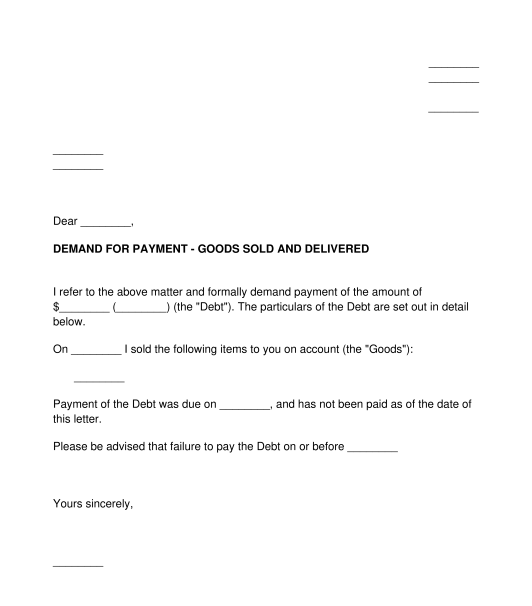 29/09/2025
29/09/2025

Answer a few questions and your document is created automatically.

Your document is ready! You will receive it in Word and PDF formats. You will be able to modify it.

A Letter of Demand can be sent to a person or organisation that has failed to make a required payment. In most cases, this letter may be used by service providers who have invoiced a client under a Service Agreement, but have not received payment from the client.
A Letter of Demand is often used as a final warning before commencing legal action for recovery of the debt. Before sending a letter of demand, service providers may wish to send more friendly reminders such as a Payment Reminder.
A Letter of Demand states how much money is being claimed, what it relates to, and when the payment must be made. It also informs the other party that if payment is not made by the date stated in the letter, then legal action may be commenced.
A Cease and Desist Letter, also known as a General Cease and Desist Notice has some things in common with a Letter of Demand, as both letters tend to be used before commencing legal action. However, a Cease and Desist Letter is sent to an individual or business that is engaging in unwelcome or illegal behaviour. The letter acts as a formal request that the recipient stop ("cease") and not continue ("desist") this behaviour. If the recipient of the letter fails to comply with these demands, then the sender may consider legal action.
A Letter of Demand, while also used before commencing legal action, does not usually relate to unwelcome behaviour. Instead, it is a demand for payment, for example, if a business has not been paid by one of its customers.
No. But a Letter of Demand provides a useful structure to enable the sender to outline their concerns in a clear and direct manner. Many people find that it is an effective way to get the debt paid.
In addition, if the matter ever proceeds to court, then in many cases, the court will want to consider the past conduct of the parties, and whether there have been any attempts to resolve the matter outside of court. If the sender is able to show that they sent a Letter of Demand but it was ignored, the court may take this into account when determining how reasonable and cooperative each party has been.
Once the letter has been finalised, it can be sent (together with any relevant attachments) to the other party.
In order to prove that the letter was sent, it may be helpful to send it by registered post.
The sender should also make note of any new due date for payment. If payment is not received by that date, then the sender will need to decide what follow up action to take. This could include contacting the debtor again, engaging a debt collector, or comencing legal action.
It is not mandatory to attach anything to a Letter of Demand. However any relevant evidence of the debt can be attached. For example, this could include copies of overdue invoices, copies of loan agreements, or other similar documentation.
A Letter of Demand should contain:
Any organisation that is involved in pursuing a debt has various legal obligations. These include obligations to avoid physical force, to avoid unreasonably harassing the debtor, and to avoid providing misleading information about the nature of the debt. Further information is available from the website of the Australian Competition and Consumer Commission.
If the money being claimed relates to the provision of goods or services, or some other agreement between the parties, then general principles of contract law, as provided by the common law, will apply.
If the sender provides goods or services to the public directly (rather than to a company) then the Australian Consumer Law may also apply.
If payment is still not received after this letter has been provided, and legal proceedings are commenced, then various other legislation in the relevant state or territory may also be relevant. For example, legislation in relation to the relevant Magistrates Court or Small Claims Tribunal may apply. If the letter is used in court as evidence, then legislation in relation to rules of evidence in the relevant state or territory may also apply.
You fill out a form. The document is created before your eyes as you respond to the questions.
At the end, you receive it in Word and PDF formats. You can modify it and reuse it.
Guides to help you
Letter of Demand - sample template - Word and PDF
Country: Australia